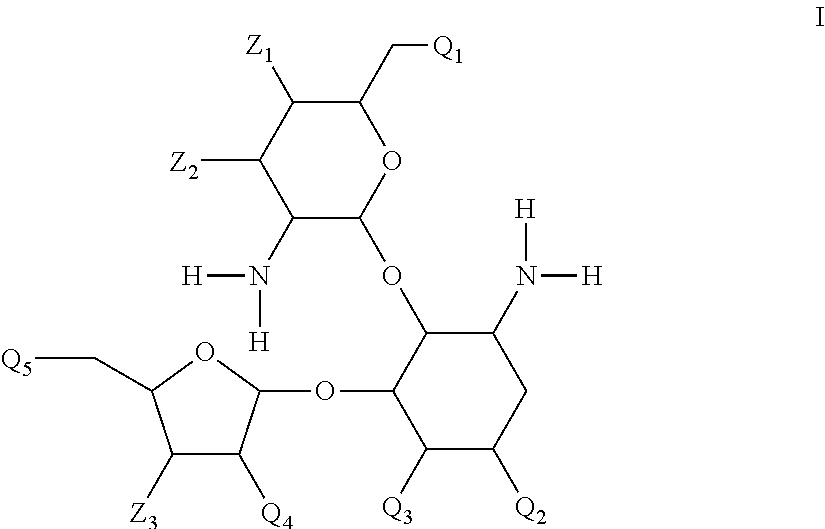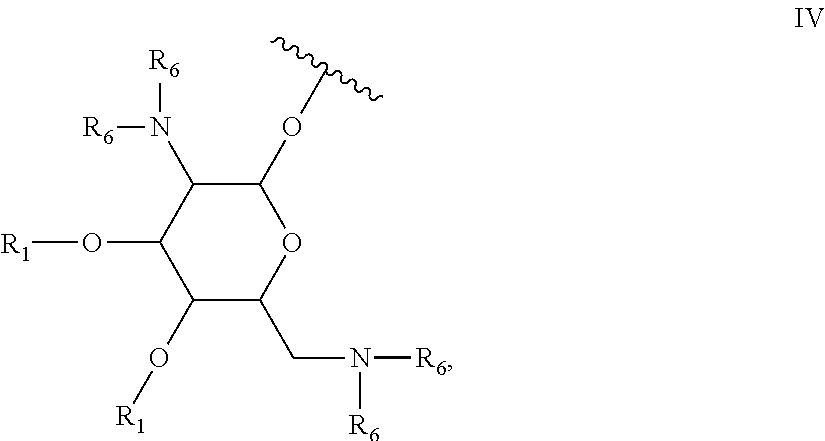Antibacterial 4,5-substituted aminoglycoside analogs having multiple substituents
a technology of aminoglycosides and aminoglycosides, applied in the field of new antibacterial compounds, can solve the problems of a single alpha helix or a single beta sheet being used in drug screening, a major limitation of classical high throughput screening, and the inability to remove a single alpha helix or turn of a beta sh
- Summary
- Abstract
- Description
- Claims
- Application Information
AI Technical Summary
Benefits of technology
Problems solved by technology
Method used
Image
Examples
example 1
4′,6′-O-benzylidene-penta-N-benzyloxycarbonyl paromomycin (2)
[0236]
[0237]Sodium carbonate (55.0 g, 0.523 mol) and Cbz-Cl (20.00 mL, 0.139 mol) were added to paromomycin sulfate (30.00 g, 0.0271 mol) in water (500 mL). After 35 hours under vigorous stirring, the water was decanted and the white precipitate was washed with water twice. A solution of triethylamine (97.00 mL, 0.697 mol) in methanol (600 mL) was added, followed by Cbz-Cl (25.00 mL, 0.174 mol). After 24 hours, dimethylamine (100 mL of a 40% aqueous solution) was added to quench the remaining Cbz-Cl. The solvents were evaporated and the oil was washed with 3% methanol in ether twice and water. The resulting sticky solid was co distilled with pyridine (200 mL) three times and at ½ of the volume of the third co distillation, toluene (200 mL) was added and the solvents were evaporated to dryness. Another co-distillation with toluene (300 mL) was done before heating the flask at 60° C. under 10 mm Hg vacuum for 12 hours. Fresh...
example 2
4′,6′-O-benzylidene-penta-N-benzyloxycarbonyl-5″-O-tert-butyldimethylsilyl paromomycin (3)
[0239]
[0240]The alcohol, Compound 2 (6.00 g, 4.367 mmol) dried by two co distillations with toluene was dissolved in CH2Cl2 (400 mL) and 2,4,6-collidine (1.15 mL, 8.735 mmol) followed by TBDMSOTf (0.50 mL, 2.184 mmol) were added at 0° C. After 18 hours, 0.6 equivalent of TBDMSOTf was added and 6 hours later, some of the CH2Cl2 was evaporated to a smaller volume for washing with HCl (0.5 M) twice and H2O. Drying with Na2SO4 and purification by silica gel chromatography (2% MeOH / CH2Cl2) gave Compound 3 (4.861 g, 75%).
[0241][α]D+41.8° (c 0.9, CHCl3); Rt 0.6 (CHCl3:EtOAc:MeOH (20:5:3); 1H NMR (300 MHz, CDCl3) δ7.60-7.10 (m, 30H), 5.60-3.00 (m, 41H), 2.20 (m, 1H), 1.30 (m, 1H), 0.83 (s, 9H), 0.01 (s, 6H); ESI m / z calcd C76H93N5O24Si 1487.60 found 1488.9.
example 3
2″-O-allyl-4′,6′-O-benzylidene-penta-N-benzyloxycarbonyl-5″-O-tert-butyldimethylsilyl paromomycin (4)
[0242]
[0243]Compound 3 (2.10 g, 1.411 mmol) was co-distilled with toluene twice and the residue dissolved in dry THF (70 mL) in a flask covered with aluminum foil. Allyl iodide (1.29 mL, 14.11 mmol) was added followed by the dropwise addition of 0.5 M KHMDS solution in toluene (1.411 mL, 0.706 mmol). The mixture was stirred for overnight at room temperature, then, 0.3 equivalents of KHMDS was added and 6 hours later the reaction mixture was quenched with an aqueous solution of NH4Cl saturated (2 mL) and water. THF was evaporated and the aqueous layer was extracted with ethyl acetate (3 times), and the organic layer was washed with a sodium thiosulfate solution, brine and dried over Na2SO4. The solvent was evaporated to dryness to afford a crude solid, which was purified by silica gel flash chromatography (1.5% MeOH / CH2Cl2) providing the corresponding allyl ether, Compound 4 (1.468 g,...
PUM
 Login to View More
Login to View More Abstract
Description
Claims
Application Information
 Login to View More
Login to View More - R&D
- Intellectual Property
- Life Sciences
- Materials
- Tech Scout
- Unparalleled Data Quality
- Higher Quality Content
- 60% Fewer Hallucinations
Browse by: Latest US Patents, China's latest patents, Technical Efficacy Thesaurus, Application Domain, Technology Topic, Popular Technical Reports.
© 2025 PatSnap. All rights reserved.Legal|Privacy policy|Modern Slavery Act Transparency Statement|Sitemap|About US| Contact US: help@patsnap.com



